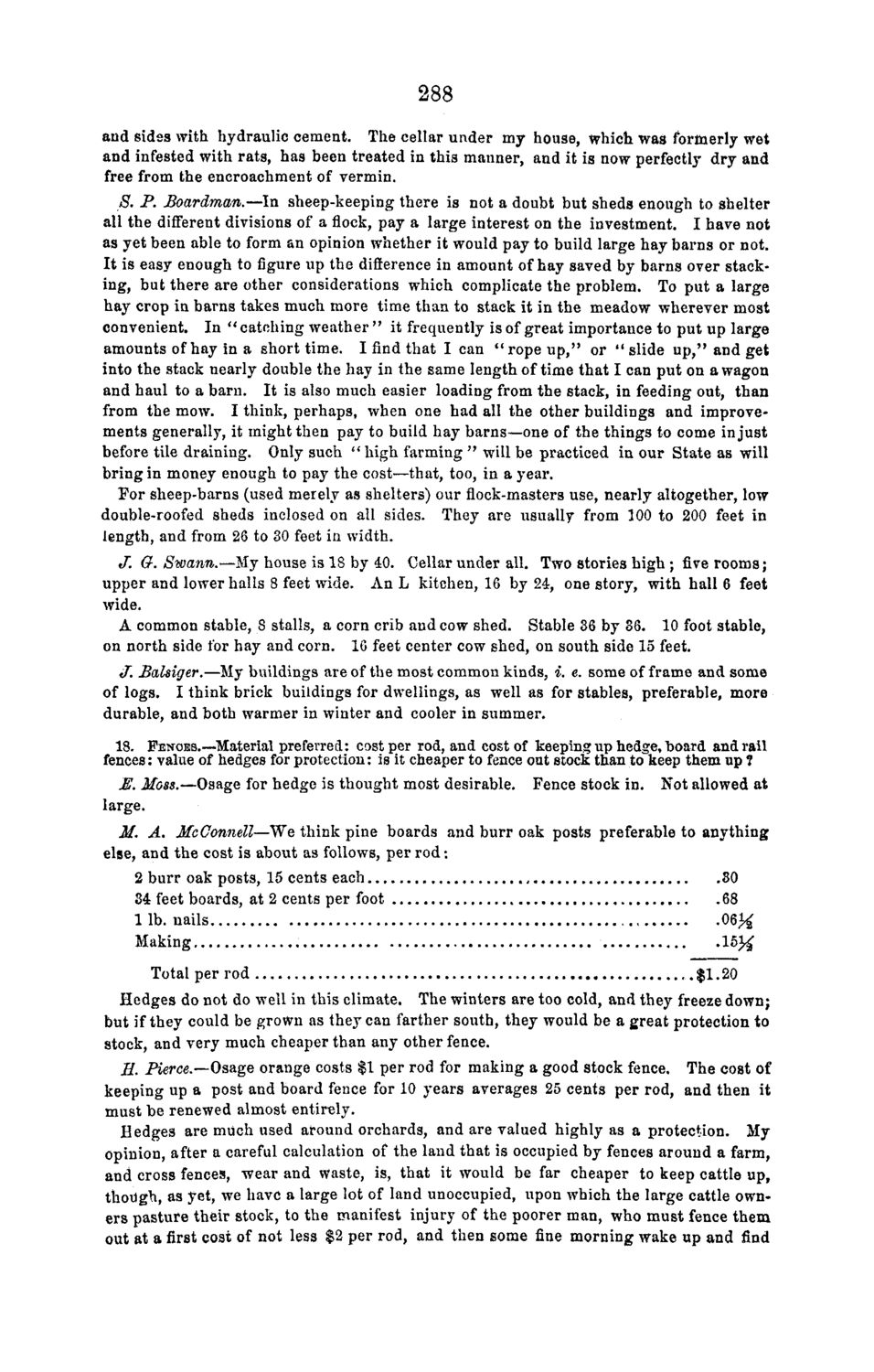| |
| |
Caption: Board of Trustees Minutes - 1868
This is a reduced-resolution page image for fast online browsing.

EXTRACTED TEXT FROM PAGE:
288 and sides with hydraulic cement. The cellar under my house, which was formerly wet and infested with rats, has been treated in this manner, and it is now perfectly dry and free from the encroachment of vermin. S. P. Boardman.—In sheep-keeping there is not a doubt but sheds enough to shelter all the different divisions of a flock, pay a large interest on the investment. I have not as yet been able to form an opinion whether it would pay to build large hay barns or not. It is easy enough to figure up the difference in amount of hay saved by barns over stacking, but there are other considerations which complicate the problem. To put a large hay crop in barns takes much more time than to stack it in the meadow wherever most convenient. In " catching weather " it frequently is of great importance to put up large amounts of hay in a short time. I find that I can "rope up," or "slide up," and get into the stack nearly double the hay in the same length of time that I can put on a wagon and haul to a barn. It is also much easier loading from the stack, in feeding out, than from the mow. I think, perhaps, when one had all the other buildings and improvements generally, it might then pay to build hay barns—one of the things to come in just before tile draining. Only such "high farming " will be practiced in our State as will bring in money enough to pay the cost—that, too, in a year. For sheep-barns (used merely as shelters) our flock-masters use, nearly altogether, low double-roofed sheds inclosed on all sides. They are usually from 100 to 200 feet in length, and from 26 to 30 feet in width. J. G. Swann.—My house is 18 by 40. Cellar under all. Two stories high ; five rooms; upper and lower halls 8 feet wide. An L kitchen, 16 by 24, one story, with hall 6 feet wide. A common stable, 8 stalls, a corn crib and cow shed. Stable 86 by 36. 10 foot stable, on north side for hay and corn. 16 feet center cow shed, on south side 15 feet. J. Balsiger.—My buildings are of the most common kinds, i. e. some of frame and some of logs. I think brick buildings for dwellings, as well as for stables, preferable, more durable, and both warmer in winter and cooler in summer. 18. FENCES.—Material preferred: cost per rod, and cost of keeping up hedge, hoard and rail fences: value of hedges for protection: is it cheaper to fence out stock than to keep them up ? JE. Moss.—Osage for hedge is thought most desirable. Fence stock in. Not allowed at large. M. A. McConnell—We think pine boards and burr oak posts preferable to anything else, and the cost is about as follows, per rod: 2 burr oak posts, 15 cents each 30 34 feet boards, at 2 cents per foot 68 l i b . nails 06^ Making 15^ Total per rod $1.20 Hedges do not do well in this climate. The winters are too cold, and they freeze down; but if they could be grown as they can farther south, they would be a great protection to stock, and very much cheaper than any other fence. B. Pierce.—Osa.ge orange costs $1 per rod for making a good stock fence. The cost of keeping up a post and board fence for 10 years averages 25 cents per rod, and then it must be renewed almost entirely. Hedges are much used around orchards, and are valued highly as a protection. My Opinion, after a careful calculation of the land that is occupied by fences around a farm, and cross fences, wear and waste, is, that it would be far cheaper to keep cattle up, though, as yet, we have a large lot of land unoccupied, upon which the large cattle owners pasture their stock, to the manifest injury of the poorer man, who must fence them out at a first cost of not less $2 per rod, and then some fine morning wake up and find
| |